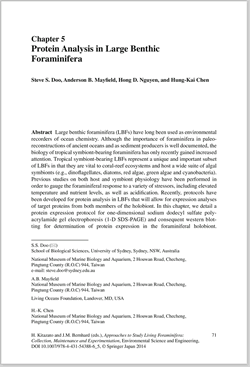Protein Analysis in Large Benthic Foraminifera
(2013)
This article, published by one of the Living Oceans Foundation Fellows, Andersen Mayfield, PhD, looks at protein analysis in large benthic foraminifera.
Protein Analysis in Large Benthic Foraminifera
Approaches to Study Living Foraminifera,
Environmental Science and Engineering
December 11, 2013
By Steve S. Doo, Anderson B. Mayfield, Hong D. Nguyen, Hung-Kai Chen
 Large benthic foraminifera (LBFs) have long been used as environmental recorders of ocean chemistry. Although the importance of foraminifera in paleo-reconstructions of ancient oceans and as sediment producers is well documented, the biology of tropical symbiont-bearing foraminifera has only recently gained increased attention. Tropical symbiont-bearing LBFs represent a unique and important subset of LBFs in that they are vital to coral-reef ecosystems and host a wide suite of algal symbionts (e.g., dinoflagellates, diatoms, red algae, green algae and cyanobacteria). Previous studies on both host and symbiont physiology have been performed in order to gauge the foraminiferal response to a variety of stressors, including elevated temperature and nutrient levels, as well as acidification. Recently, protocols have been developed for protein analysis in LBFs that will allow for expression analyses of target proteins from both members of the holobiont. In this chapter, we detail a protein expression protocol for one-dimensional sodium dodecyl sulfate polyacrylamide gel electrophoresis (1-D SDS-PAGE) and consequent western blotting for determination of protein expression in the foraminiferal holobiont. This technique has the potential to target proteins that are specific to either host or symbiont compartments, a breakthrough that may ultimately allow for an increased understanding of the molecular-scale regulation of the symbiosis that is vital to these globally important calcifiers.
Large benthic foraminifera (LBFs) have long been used as environmental recorders of ocean chemistry. Although the importance of foraminifera in paleo-reconstructions of ancient oceans and as sediment producers is well documented, the biology of tropical symbiont-bearing foraminifera has only recently gained increased attention. Tropical symbiont-bearing LBFs represent a unique and important subset of LBFs in that they are vital to coral-reef ecosystems and host a wide suite of algal symbionts (e.g., dinoflagellates, diatoms, red algae, green algae and cyanobacteria). Previous studies on both host and symbiont physiology have been performed in order to gauge the foraminiferal response to a variety of stressors, including elevated temperature and nutrient levels, as well as acidification. Recently, protocols have been developed for protein analysis in LBFs that will allow for expression analyses of target proteins from both members of the holobiont. In this chapter, we detail a protein expression protocol for one-dimensional sodium dodecyl sulfate polyacrylamide gel electrophoresis (1-D SDS-PAGE) and consequent western blotting for determination of protein expression in the foraminiferal holobiont. This technique has the potential to target proteins that are specific to either host or symbiont compartments, a breakthrough that may ultimately allow for an increased understanding of the molecular-scale regulation of the symbiosis that is vital to these globally important calcifiers.